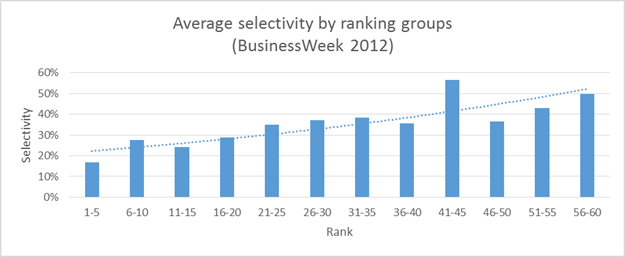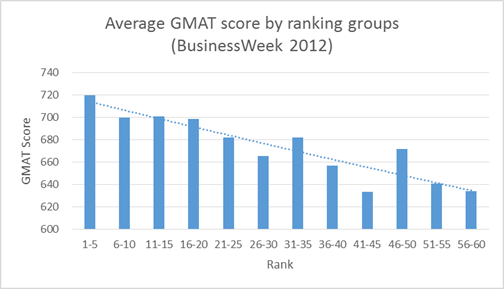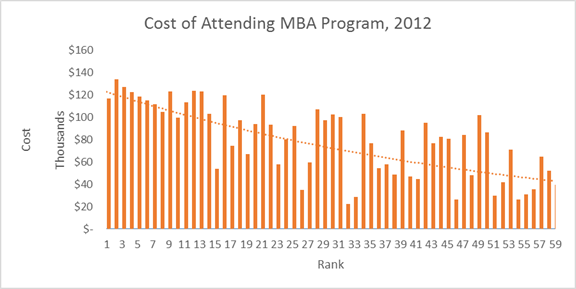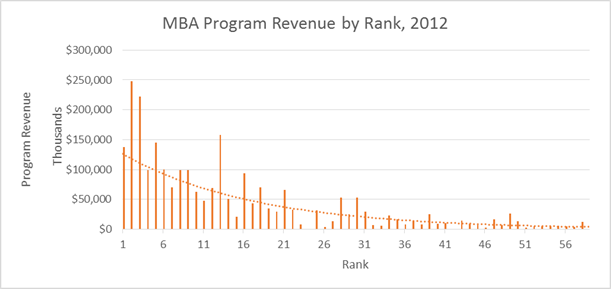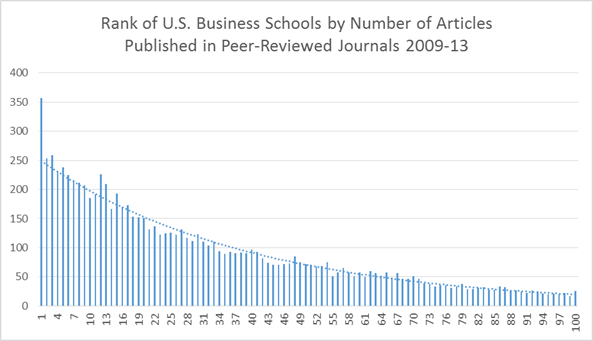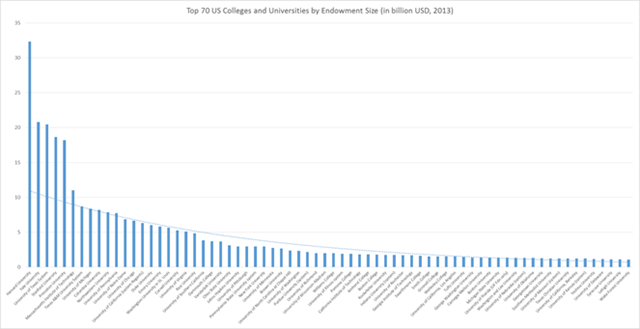In my last blog post, I profiled the attributes of “winners-take-all” markets. And I implied that such markets might be closer than you think. Well, they are for me.
Higher education is a winners-take-all market. Despite the cool indifference to competition that many academicians affect, the competition among colleges and universities is serious. Aside from the fact that most people want to belong to a community that matters in some respect, some faculty, staff, parents, students, alumni, governments, and media mavens ask a provocative question: “Why strive?” In other words, why should institutions keep piling on the investment in programs, faculty compensation, facilities, and the like? Isn’t the institution of X years ago sufficient to the mission? The winners-take-all concept helps to explain what’s going on, and presents a rather depressing outlook. But I think there is a way out of the morass. Let me tell you how and why.
The Self-Reinforcing Cycle in Higher Education
To start with, consider the evidence that higher education is a winners-take-all market. The two most prominent attributes of such markets are that (1) assessment is based on relative, not absolute, performance, and (2) that rewards are concentrated in the hands of a few top performers. Higher education models these attributes well.
Relative assessment. In a world of absolute assessment, a college or university would ask itself, “Did we fulfill our mission? How well did we do it?” In this world of relative assessment, the question would be, “How well did we do it compared to a benchmark of other schools?” That institutions compare themselves to other schools is no secret: most collegiate associations provide databases by which leaders can easily make such comparisons. More importantly, many external sources provide ratings or rankings, some followed by millions of readers. (In previous blog posts I have criticized the rankings (see this and this).) Despite the criticisms, we know that people pay attention to these relative assessments: material changes in rankings seem to trigger material changes in the volume of applications for admission, philanthropic gifts, media attention, and the success of faculty recruiting efforts. For instance, a study by Michael Luca and Jonathan Smith found, “a causal impact of rankings on application decisions. When explicit rankings of colleges are published in U.S. News, a one-rank improvement leads to a 1-percentage-point increase in the number of applications to that college.” Forbes Magazine reported, “Just as an analyst’s upgrade can spark a rally in a specific stock, a college’s move up the rankings usually results in a financial windfall. “There’s institutional pressure at colleges to achieve at all levels, and that includes rankings,” says Troy Onink, a college planning expert and FORBES contributor. “It’s a hypercompetitive world for the best students and for that tuition revenue.””
Concentration of rewards. To the victors belong the spoils. In the previous post, I characterized the payoffs in winners-take-all fields as highly asymmetric (to math geeks, it might look like an exponential growth curve): the winners get a lot and the rest get a little. Here are some examples.
Textbook sales, Ph.D. production, and article citations. In his seminal article on the winners-take-all phenomenon (“The Economics of Superstars,” 1981), Sherwin Rosen wrote, “sales of elementary textbooks in economics are concentrated on a large group of best sellers, though there exists a large number of very good and highly substitutable alternatives in the market (the apparent inexhaustible supply of authors willing to gamble on breaking into the select group is one of the reasons why so many are available). A small number of graduate schools account for a large fraction of Ph.D.s. A relatively small number of researchers account for a large fraction of citations and perhaps even articles written.” (p. 845).
Admissions selectivity. “Reward” could also be measured by the ability to recruit excellent students. Consider some evidence from US business schools. One metric would be the selectivity ratio of admissions (the number of offers of admission divided by the number of applicants). This graph shows that the higher the rank, the more selective the admissions.
Another aspect of selectivity would be the ability to attract students of high academic promise. The following graph relates the average GMAT test score by ranking group (the Graduate Management Admissions Test is the leading standardized admissions test in the field). The graph reveals a strong association between rank and test score.
Of interest here is the association between rank and selectivity or average GMAT score. As the following table shows, the correlation percentages are high by typical experience in social sciences. (Note that BusinessWeek does not use the GMAT and selectivity ratios in computing its rankings.)
| GMAT Score | Admission Selectivity | |
| Correlation with Ranking Groups | -91% | 85% |
| Correlation with Rank of Individual Schools | -81% | 66% |
Ability to command premium prices. Another way to consider concentration of rewards is to look at the ability of a school to command a high price for its degree program. Sure enough, as the following graph shows, there is an association between ranking (judging business schools on relative, not absolute, performance) and rewards: as ranking falls, so does price.
Program revenue. Or, you can see concentration of rewards in terms of total revenue of an MBA program. Revenue measures both the ability to command a high price and to attract large numbers of students at that price.
Research hits. Business schools also display a strong asymmetry in research productivity. Here is a graph based on rankings and research publications collated by the University of Texas—Dallas.
Federal Government Research Grants. In its annual report for 2011, the Center for Measuring University Performance presented evidence of a strong winners-take-all phenomenon in the ability of institutions to attract federal grants. Here are some excerpts:
A relatively few top performers among research institutions control a large percentage of the market and this concentration remains stable over time….This distribution is a little more unequal than the most unequal country income distribution in the world.((“The Top American Research Universities” 2011 Annual Report, the Center for Measuring University Productivity, pages 3-9))
Endowment. The ability to draw philanthropic gifts to support the school is another measure of the distribution of rewards. Nothing succeeds like success. The leader in the field, Harvard University, just announced the commencement of a $6 billion capital campaign.
Other. I will assert (and leave it for others to research) that in addition to pricing and research grants, higher education displays winners-take-all attributes in respect to faculty prominence, physical facilities, media attention, and so on.
You get the idea. Institutions of higher education in America are subject to strong winners-take-all forces.
Implications: The Self-Reinforcing Cycle
Students of the winners-take-all phenomenon point to feedback effects by which strengths reinforce reputation which reinforces strengths. You get to be known as a winner which draws attention, strong students, leading faculty, happy alumni, growing research grants, and big donations. This is a self-reinforcing virtuous cycle.
Of course, the cycle can work in reverse. Some shock triggers doubt and disbelief in the school—perhaps it’s a tragic shooting, wave of exam cheating, sexual abuse, NCAA violations, a loss of accreditation, a governance crisis, or faculty strike. Or perhaps it is an external event such as a market crash that wipes out a school’s endowment or the advent of new technology. In a recent interview, Rich Lyons the Dean of UC Berkeley’s Haas School of Business was quoted as saying,
“Half of the business schools in this country could be out of business in 10 years—or five,” he says. The threat, says Lyons, is that more top MBA programs will start to offer degrees online. That will imperil the industry’s business model. For most business schools, students pursuing part-time and executive MBAs generate crucial revenue. Those programs, geared toward working professionals, will soon have to compete with elite online alternatives for the same population.” ((“Half of US Business Schools Might Be Gone by 2020” Bloomberg BusinessWeek March 14, 2014. http://www.businessweek.com/articles/2014-03-14/online-programs-could-erase-half-of-u-dot-s-dot-business-schools-by-2020?campaign_id=DN031414)))
As applications, quality of students, donations, and affirmative media coverage fall, so do rankings. And the cycle continues: more doubt and disbelief; more declining relative performance; fewer rewards. The school stalls, and then nose-dives. This is a self-reinforcing pernicious cycle.
Given a choice, most academic leaders will strive to place their institutions on the self-reinforcing virtuous cycle. Such striving explains some part of the ongoing ample investment in people, programs, and facilities at business schools, colleges, and universities. America, in particular, has always been a society of strivers. Therefore, the behavior of higher education may seem to be a piece of the larger culture.
A Caution
But reaching for the virtuous may still result in the pernicious. Consider some possibilities.
Recruiting talent. A school seeking to rise in a winners-take-all field could alter its recruitment of faculty and students in an effort to look just like some schools higher up the food chain. The downside of this is to draw people into the community who may not share the values or sense of mission of the school. Or it may promote conformity. “Late bloomers” or oddballs may have something to teach their classmates either now or later—as the lives of Steve Jobs, Bill Gates, and Larry Ellison show.
Dumbing down the curriculum. A cynical way to recruit is to lower the standards of performance: less teaching for the faculty, grade inflation or lighter degree requirements for students. The term, “Mickey Mouse degrees,” gained currency in 2003 when Margaret Hodge, the UK Minister for Universities, faulted programs “where the content is perhaps not as [intellectually] rigorous as one would expect, and where the degree, itself, may not have huge relevance in the labour market…simply stacking up numbers on Mickey Mouse courses, is not acceptable.”
Gaming the system. The winners-take-all payoffs create a strong incentive to cheat. Recent news stories have reported the falsification of data reported to major collegiate rankings by Claremont McKenna, Bucknell, Tulane, Iona, and Emory (see this, and this). The 2012 survey of College and University Admissions Directors by Inside HigherEd found that “Nearly all institutions (99 percent) report that they have not falsified student admissions data; most (91 percent) report that they think other institutions have falsified such data.” (Pg.1)
Not Merit but… A high reputation could reflect momentum in terms of size, a media blitz to inflate a past legacy, social capital (or promise of membership in an elite community), influence, or wealth rather than real academic merit. The “stickiness” in the rankings, NSF league tables, and seedings in athletic competitions are not inconsistent with this. Which is the cause and which the effect? Do schools win relatively high reputations based on merit, or based on the “bling” one associates with merit?
Managing to the rankings. In an influential report on research universities, John Lombardi wrote, “If…the university emphasizes behaviors that influence the rankings elements but do not necessarily improve the performance of the institution, then the impact of the league table is negative. Even more significantly, if the importance of the league table in sorting institutions by reputation has an impact on access to resources or the imposition of government policies and controls, the influence of the ranking can easily become pernicious. Universities and other academic units ranked in these contests may also work to manipulate their data by strategies that give them a comparative advantage in the rankings unrelated to their actual performance. Other than simply submitting fraudulent data (which can happen and which is why good rankings are always transparent and provide all the data and calculations for public review), universities can pursue other strategies. If high scores on entrance exams figure significantly in the calculation of an important ranking, universities can divert funds to increase the scholarships used to entice students with exemplary entrance exam results to enroll. By buying students with better examination scores, the institution’s ranking will increase although the institution itself may not have become better.”((“In Pursuit of Number ONE” by John V. Lombardi, The Top American Research Universities, 2010 Annual Report, Center for Measuring University Performance, page 9.))
The Investment Treadmill. When an institution decides to compete in the winners-take-all competition, it commits itself to a path from which it may be difficult to depart and which will demand rising commitments. Perhaps this results from “striving” (mentioned earlier) or sunk cost thinking. Either way, the demands for investment can be impressive. Consider again the commentary from the CMUP report on research universities:
This competition is constrained by the structural characteristics of the marketplace. Within the top 150 to 200 performers, mostly the same institutions compete every year. This competition is an essential element of their institutional design and mission and they must participate to remain major research universities within the United States. Success in this competition is a function of investment and careful management of institutional subsidies over time.
Research is one of the university’s loss leaders. Almost no research reflected in this competition pays its full costs. Instead, the federal research expenditures reflect only a partial reimbursement of the institution’s investment in that research. Universities need to understand the opportunities and constraints of the research marketplace as they budget funds to subsidize competitive research activities…
…Another way to look at the structure of this distribution is to measure how much it would take to move the middle institution in each group to the midpoint of the group above it. The purpose of this kind of approach is to identify the challenge faced by universities that commit themselves to the investment required to make a major change in their competitive position…
These [comparisons] indicate the strong structure of this marketplace over the past decade and highlight the major effort needed to move an institution a significant distance within this competitive context.2011 Annual Report, the Center for Measuring University Productivity, pages 3-9))
Resisting the treadmill
The winners-take-all market in higher education poses an existential problem for educational leaders. The vast majority of institutions don’t display the attributes of winners and therefore have little hope of reaping the rewards to which they might aspire. The competition to excel and to join the small pool of winners is really intense. Aspirants keep elbowing into one’s competitive space. Overcrowding prompts heavier investment in an effort to get ahead, or just keep up with the crowd. Various constituents prod the leaders of the institution, demanding no relaxation of the race. Falling behind isn’t an option because just as there is a self-reinforcing feedback loop that helps schools as they rise, there is a vicious negative feedback loop that can suck schools downward. Strive for the good and avoid the bad—but resources are finite and burnout looms. By what reasonable strategy could a school respond to the winners-take-all market and survive?
The first priority must be to avoid the paths that are traps. For instance:
-
Continuing to invest heavily in technology, MOOCs, financial aid, faculty, buildings, amenities, and so on when the school can’t afford it. For the majority of schools the winners-take-all treadmill is unsustainable. It is useless to compete with competitors who have very deep pockets.
-
Doing nothing. In the face of the turbulent changes looming for higher education, standing still is not an option. Recall Rich Lyons’ prediction (see above). Or see a prescient article in The Economist, entitled, “Trouble in the Middle.”
-
Giving up. A school could simply surrender and close its doors. Ray Brown reports that some 74 American institutions closed since 2000—many multiples of that number merged into other institutions.(( http://www2.westminster-mo.edu/wc_users/homepages/staff/brownr/closedcollegeindex.htm)) Such harsh steps could be warranted for schools in depressed regions or that have lost their way. But this hardly serves the educational mission to which so many faculty and staff members are called; nor does it serve the wider constituency of any school.
-
Collusion. Frank and Cook, the authors of the Winner-Take-All Society, advise “positional arms-control agreements” to limit wasteful spending. This breaks the “prisoner’s dilemma” whereby competing schools realize their mutual self-interest and agree to a set of practices that ensure survival. The authors cite “redshirting” in college athletics, and the practices within the Ivy League that limit excessive spending on sports. The downside is that such agreements are easily broken by unruly upstarts—think of the oil cartel. Moreover, collusion can often descend into a restraint of trade, through price-fixing and conspiratorial admissions policies.
The other path
Find a defensible niche and work to dominate it. Recall that the problems with the winners-take-all market are overcrowding and positioning that is based on relative, not absolute, performance. Everything depends on how you frame your school’s identity, and thus by inference, how you frame the field it serves and within which it competes. Therefore, the other path would be to compete for relative position in a defensible, important, and possibly smaller field. This takes great clarity about mission and purpose. It is risky if you define your niche in a way that is unappealing to the constituents to whom you appeal.
One way to discover the defensible niche and manage the risks is to be “effectual.” My colleague, Professor Saras Sarasvathy, has studied “expert entrepreneurs,” people who started at the wrong end of the “winners-take-all” food chain and still created a winning outcome. She concluded that these people thought in a very different way compared to novice entrepreneurs, those more likely to fail than the experts. The chief difference was that the expert entrepreneurs thought in terms of effects or outcomes, rather than causal if-then logic. Saras offers an example: a chef focused on causation will plan a menu and cook according to what the customer is likely to eat; but a chef focused on effectuation will see what is available or “fresh today” and prepare the best meal with the ingredients at hand. Her theory of “effectuation” has had revolutionary impact on the way business schools train entrepreneurs. I believe that her lessons are also relevant to leaders in higher education, especially those who are bedeviled by a belief that the “winners-take-all” market is stacked against their institutions. At Darden, Saras’s principles have spawned a set of effectual pratices that help us to contend with winners-take-all.
In particular, Saras has highlighted five principles:
-
“When expert entrepreneurs set out to build a new venture, they start with their means: who I am, what I know, and whom I know. Then, the entrepreneurs imagine possibilities that originate from their means.” Successful entrepreneurs don’t start with goals, they start with resources, capabilities or tools that are at hand. They focus on what they have, not with what they wish they had. They ask, “What can I do with what I have?” Think of the effectual chef—I suspect that parents cook effectually for their children more often than they might admit. For faculty and administrative leaders, this requires an absolutely fearless, sober, and candid assessment of the competencies of the institution. What are the school’s strengths? Take care that this assessment should be based on absolute, rather than relative, assessments of performance. The next step is to ask what the school can do to exploit these strengths. At Darden, we conduct an annual leadership retreat to explore these questions and frame new projects, experiments, prototyping, and design efforts with which to challenge ourselves. The incumbents and aspirants in the niche we define keep changing. Therefore, we don’t settle for a “once and done” definition of the service we give.
-
“Expert entrepreneurs limit risk by understanding what they can afford to lose at each step, instead of seeking large all-or-nothing opportunities. They choose goals and actions where there is upside even if the downside ends up happening.” Launch first, profits later. The question that kills so many fledgling ventures is, “How much money will you make and when will you make it?” The reality is that no one knows. You must consider the launch of a start-up much like buying an option. You spend a little money to see what happens. If the initial results are nice, you spend a little more, and so on. Thus, the dominant questions that successful entrepreneurs ask are, “How big a loss can I afford? And what can I do to minimize that loss?” For faculty and administrative leaders, this probably means avoiding big-budget high-stakes bets, the academic equivalent of the moon shot, the Manhattan Project, or the D-Day Invasion. Instead, it probably entails making a range of little bets, seeing what pays off, and successively nurturing the winners. In this regard, I have previously recommended the book by Peter Sims, Little Bets: How Breakthrough Ideas Emerge From Small Discoveries. It is a delightful and provocative reading about the origin of innovation. At Darden, we have been using the theory of little bets very successfully in areas such as the development of MOOCs, field experiences, behavioral research, and communications and marketing.
-
“Expert entrepreneurs build partnerships with self-selecting stakeholders. By obtaining pre-commitments from these key partners early on in the venture, experts reduce uncertainty and co-create the new market with its interested participants.” Partner early and often. Saras says, “Entrepreneurs cooperate with parties they can trust. These parties can limit the affordable loss by giving pre-commitment.” As the old Beatles song says, “I get by with a little help from my friends.” The social network can be powerful, not only for the financial resources it affords, but also for the doors it may open to other relationships. At Darden, we expanded our network of corporate partners and discovered a new circle of support that culminated in the founding of our Institute for Business in Society.
-
“Expert entrepreneurs invite the surprise factor. Instead of making “what-if” scenarios to deal with worst-case scenarios, experts interpret “bad” news and surprises as potential clues to create new markets…Surprises are not necessarily seen as something bad, but as opportunities to find new markets.” The discovery of the wildly popular Post-It Notes® by 3M Corporation was triggered by the failure of an adhesive—the scientist simply tried an alternative application for the semi-sticky glue. If an initiative hits dead-end, the academic leader may be inclined to abandon it—if so, it is always useful to ask, “What did we learn from this? What can we do with what we learned?”
-
“By focusing on activities within their control, expert entrepreneurs know their actions will result in the desired outcomes. An effectual worldview is rooted in the belief that the future is neither found nor predicted, but rather made.” So many of the dire predictions for higher education are fatalistic. I like Saras’s fifth principle because it reflects a spirit of self-determination. Applying this in an academic setting may require a cultural shift. A slogan among my colleagues at Darden is standing still is not an option. Whatever happens, we want to get on with realizing our highest potential.
Effectuation is relevant for higher education because it employs non-predictive strategies and thus allows one to create and grow in an environment of uncertainty and unpredictability. Predictive strategies in higher education are risky, because we can hardly foresee with any amount of confidence what higher education of the future will look like.
Saras Sarasvathy wrote, “Underlying all the principles of effectual reasoning is a coherent logic that rests on a fundamentally different assumption about the future than causal reasoning. Causal reasoning is based on the logic, To the extent that we can predict the future, we can control it. That is why both academics and practitioners in business today spend enormous amounts of brainpower and resources on developing predictive models. Effectual reasoning, however, is based on the logic, To the extent that we can control the future, we do not need to predict it.” ((Sarasvathy, S. D. (2001). “What Makes Entrepreneurs Entrepreneurial” Darden Business Publishing.))
Conclusion: The future made
Today, higher education resembles a winners-take-all market. To win is great, gratifying, and reinforcing. But striving to be one of the winners is fraught with great difficulty: heavy investment, long duration with slow advancement, and serious temptations to err—it may place the school on a long and weary treadmill that is unsustainable and ultimately dangerous. Fortunately, there is an alternative: find strategic advantage through defining a defensible niche in higher education by means of effectual thinking. To do this, an educational leader must stop seeing competition as a game or a “hunt” in the first place. The point is not to “win” within an existing market but to “create” new possibilities and enduring value. An effectual approach argues for a move away from a hunter-gatherer mentality of “the” education market and toward a more plural agrarian view of co-created niches that we will design and redesign into gardens we cannot even imagine today.
Note: I thank Asif Mehedi (D’12), research assistant, for effective and effectual contributions to this post. And I am grateful to Saras Sarasvathy for comments.

